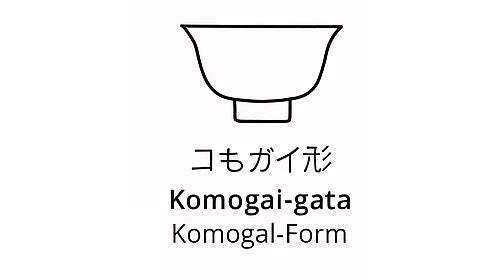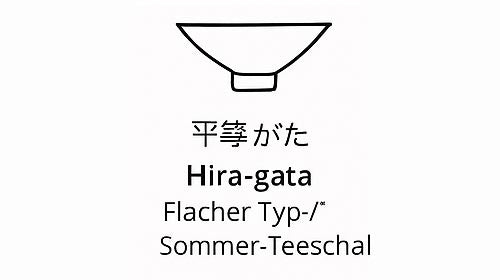The Komogai-gata chawan is often described as the "feminine" of matcha bowls. Its name is a combination of "komogai" (小最) – an older euphemism for delicate, noble things – and "gata" (形), meaning shape. This bowl is graceful, soft, yet functional and not overly playful.
Shape & Proportion
Typical of the Komogai-gata is its slight tapering in the middle , a shape that lies between a delicate tulip opening and a classic wan-nari. The walls are fine, the upper rim gently flared, and the body slightly curved.
This subtle curve creates an extremely pleasant feel. In the hand, the bowl feels like a movement—not like a container. The inner curve is fluid, ideal for striking usucha, as the chasen can be handled harmoniously.
Symbolism & Origin
The komogai-gata became particularly popular in the late Edo period (18th–19th centuries), a period in which aesthetics, poetry, and everyday life became more closely intertwined. Bowls of this type were preferred in private tea-making practices and by women —not for functional reasons, but for aesthetic reasons.
Some female ceramicists deliberately began to create softer, finer chawan forms that were less austere than Tsutsu-gata or Dojimari-gata. The Komogai-gata is the result of this development.
Glaze & Production
Preferred glazes:
-
Whitish-transparent Kohiki
-
Delicate shades of blue, partly with craquelure
-
Slightly shiny ash glazes on light clay
Usually produced on a potter's wheel with reduced firing. Often in Mino, Mashiko, and modern workshops in Kyoto.
Application
Ideal for usucha , especially in quiet, private ceremonies. Its shape makes it easier to prepare and drink – especially for smaller hands. The open center gives the matcha presence, but not overpowering.
SEO focus:
“Feminine matcha bowl,” “delicate chawan,” “buy komogai-gata,” “chawan for usucha” – search queries that consciously focus on aesthetics and handling lead directly to this shape.
8. Tsutsu-gata Chawan – The Form of Silence and Winter
Meta description: The Tsutsu-gata chawan is tall, cylindrical, and meditative. Discover its use in winter, its history, and its significance in the tea tradition.
Blog post:
The Tsutsu-gata , also called a cylindrical bowl, is one of the most impressive chawan shapes in Japanese tea aesthetics. Its name, "Tsutsu" (筒), means cylinder or tube, and "gata" means shape. It is a vertical bowl, entirely focused on recession and depth.
Characteristics & Proportion
Taller than other chawans, they often have a narrow rim and nearly vertical walls. This construction ensures that heat is retained for a long time—an important feature for winter tea ceremonies .
The interior is deep, often slightly conical. This somewhat limits the ability to whip usucha, which is why it is used almost exclusively for koicha .
Origin & Use
The Tsutsu-gata was developed in the late Muromachi period , inspired by Chinese tea bowls, and later perfected in Raku workshops in Japan. Its closed form embodies wabi —the idea of retreat, reduction, and concentration.
It is used primarily in winter ceremonies or in very quiet, formal contexts where concentration and inwardness are emphasized.
Materials & Glaze
-
Raku-Yaki with deep black or reddish glaze
-
Coarse Shigaraki clay with ash flecks
-
Subtle iron glazes with a dark shine
The base is usually medium-high and centered, as the base needs to provide a lot of stability due to the high design.




Leave a comment
This site is protected by hCaptcha and the hCaptcha Privacy Policy and Terms of Service apply.